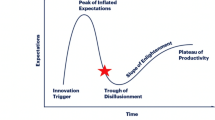Abstract
The modern operating room is full of data. In an age of data science and artificial intelligence, we believe that this vast amount of surgical data should be exploited to construct an AI-based surgical control tower that can model and analyze surgical processes as well as support surgical decision and action.
Access this chapter
Tax calculation will be finalised at checkout
Purchases are for personal use only
Similar content being viewed by others
Notes
- 1.
Maier-Hein L. et al., “Surgical Data Science: Enabling Next-Generation Surgery,” Nature Biomedical Engineering, 2017, vol. 1, 691–696.
- 2.
Carinou E., Brodecki M., Domienik J., Donadille L., Koukorava C., Krim., Nikodemova D., Ruiz-Lopez N., Sans-Merce M., Struelens L., Vanhavere F., “Recommendations to reduce extremity and eye lens doses in interventional radiology and cardiology,” Radiation Measurements, 2011, vol. 46, no 11, 1324–1329.
- 3.
Loy Rodas N., Barrera F., Padoy N., “See It with Your Own Eyes: Markerless Mobile Augmented Reality for Radiation Awareness in the Hybrid Room,” IEEE Trans. Biomed. Engineering, 2017, 64(2), 429–440.
- 4.
Loy Rodas N., Bert J., Visvikis D., de Mathelin M., Padoy N., “Pose optimization of a C-arm imaging device to reduce intraoperative radiation exposure of staff and patients during interventional procedures,” ICRA, 2017, 4200–4207.
- 5.
Kadkhodamohammadi A., Gangi A., de Mathelin M., Padoy N., “Articulated clinician detection using 3D pictorial structures on RGB-D data,” Medical Image Analysis, 2017, 35, 215–224.
- 6.
Twinanda A.P., “Vision-based approaches for surgical activity recognition using laparoscopic and RGBD videos,” Ph.D. thesis, Strasbourg University, 2017.
- 7.
Twinanda A.P., Shehata S., Mutter D., Marescaux J., de Mathelin M., Padoy N., “EndoNet: A Deep Architecture for Recognition Tasks on Laparoscopic Videos,” IEEE Trans. Med. Imaging, 2017, 36(1), 86–97.
- 8.
Aksamentov I., Twinanda A.P., Mutter D., Marescaux J., Padoy N., “Deep Neural Networks Predict Remaining Surgery Duration from Cholecystectomy Videos,” MICCAI (2), 2017, 586–593.
Author information
Authors and Affiliations
Corresponding author
Editor information
Editors and Affiliations
Rights and permissions
Copyright information
© 2020 Springer Nature Switzerland AG
About this chapter
Cite this chapter
Padoy, N. (2020). Toward an Operating Room Control Tower?. In: Nordlinger, B., Villani, C., Rus, D. (eds) Healthcare and Artificial Intelligence. Springer, Cham. https://doi.org/10.1007/978-3-030-32161-1_16
Download citation
DOI: https://doi.org/10.1007/978-3-030-32161-1_16
Published:
Publisher Name: Springer, Cham
Print ISBN: 978-3-030-32160-4
Online ISBN: 978-3-030-32161-1
eBook Packages: Intelligent Technologies and RoboticsIntelligent Technologies and Robotics (R0)



